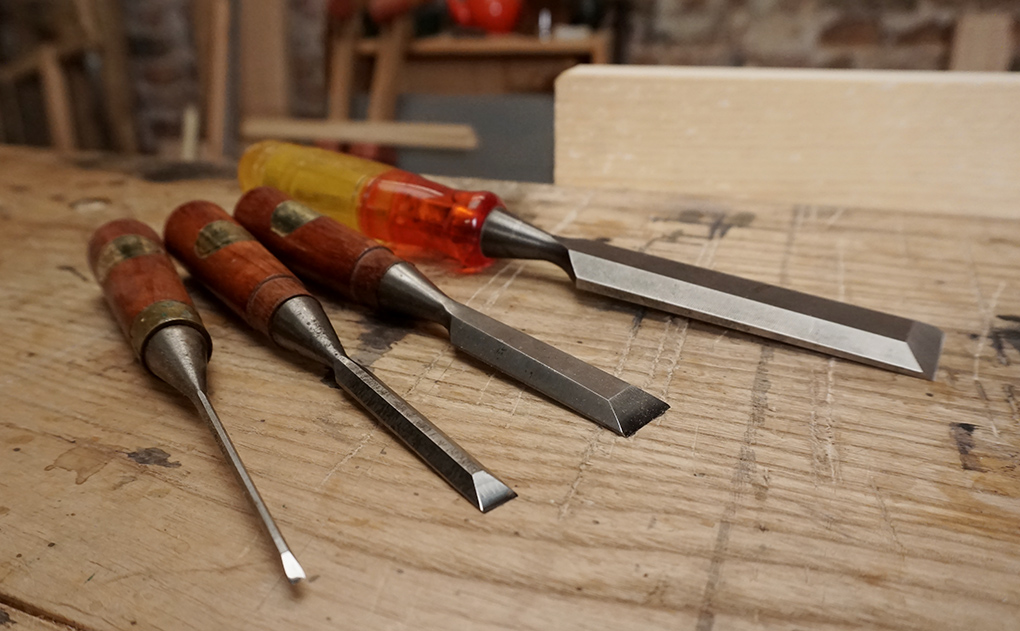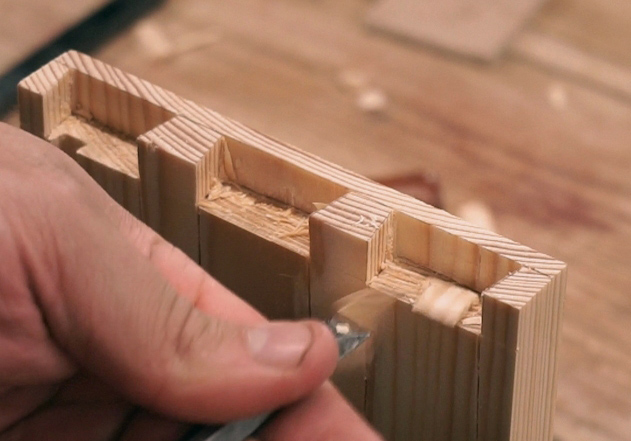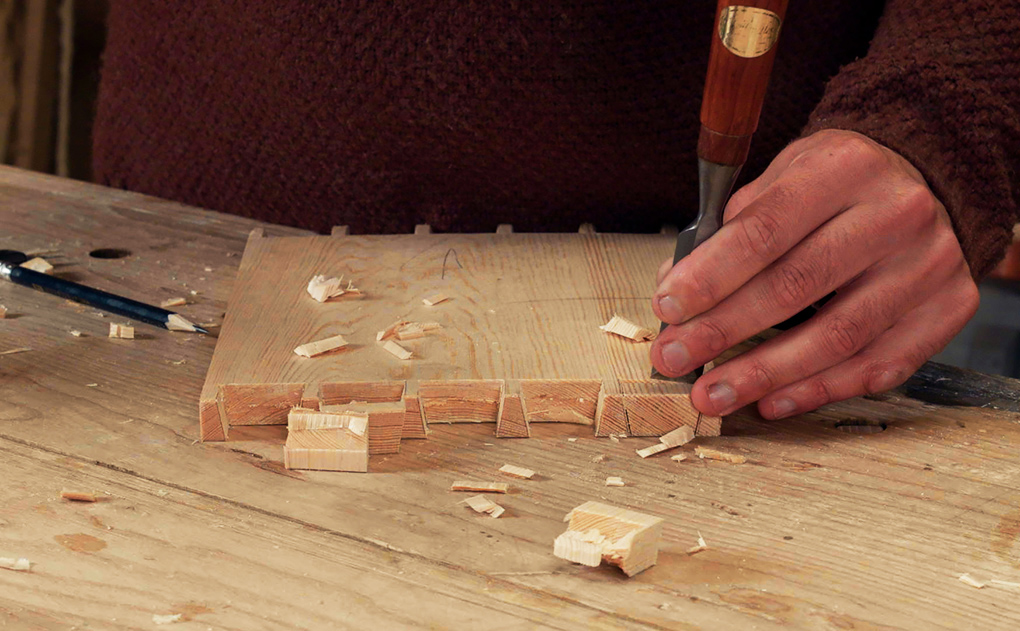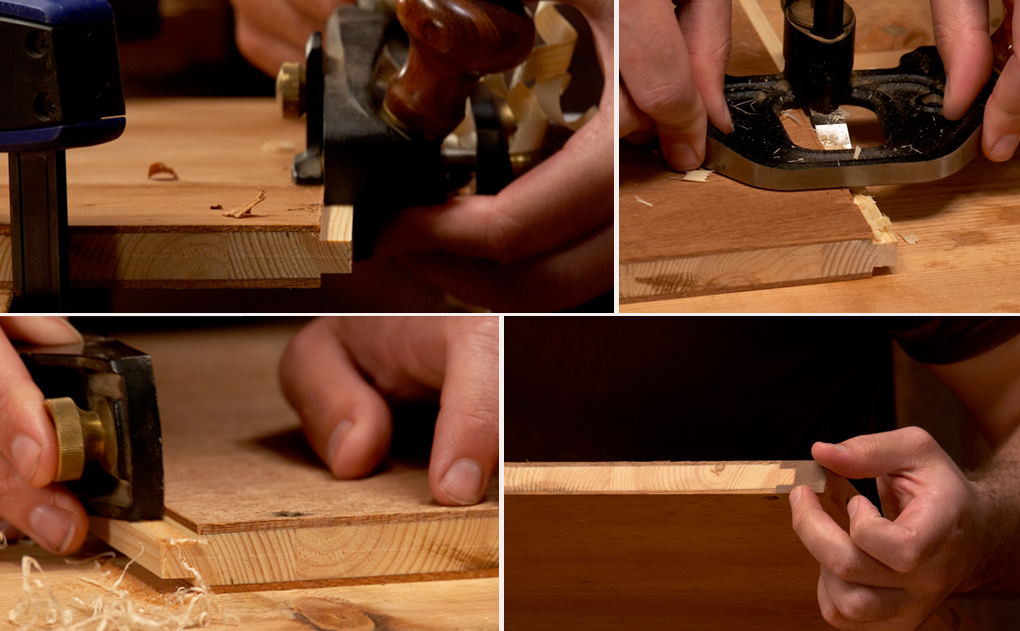No matter how quick and functional a build may be in everything we make, we should be aiming at clean, tight joints.
I don’t like excuses for shoddy joinery.
For the most part my Marples bevel edge chisels are up to this task. But some joints demand a bit more refinement and more importantly, efficiency.
If you do a lot of dovetailing, then you’ll definitely benefit from some finer chisels.
A Fine Bevel
I have a dedicated set of fine bevel edge chisels for this reason. Ones where the bevel goes to an elegant, almost sharp point along the sides.
Not only do these make it easier to cut tight joints, but they help you to do it with more pace.
A well placed cut will relieve the waste without damaging any of the good stuff. So that fine bevel gives you confidence.
And confidence is important. We don’t want to be hesitant or half committed.
Shallow Cutting Angle
Since I have a dedicated set of dovetail chisels I’m able to keep them set with a very shallow cutting angle.
This is perfect for giving a good deep chop with every cut.
Since the cleanest, most efficient way to cut any joint is to minimise the number of cuts you make, that shallow angle really counts.
Another tremendous benefit of a rather low cutting angle, (20-22 degrees) is that the chisel doesn’t have that nasty tendency to jump back past the gauge line. Efficient and clean.
Short & Agile
Along with a fine bevel, there are two other factors I consider important in a chisel for dovetailing.
Firstly I want high carbon/ O1 steel.
That goes for all my tools, and is a preference I have mainly for the swift sharpening routine this softer steel allows.
[See this post if you struggle with sharpening narrow chisels.]
Secondly I favour them short. Short blade and a short handle. Or butt chisels.
Butt chisels are about a third of the length of a conventional chisel. I love these for dovetailing because they’re stupendously agile.
When strength is less important, a tool may as well be optimised for good handling. I favour the butt chisels for cutting dovetails because I can throw them straight on my lines and whack away. In the hand they feel more like a good knife than a chisel.
When you’re cutting dovetails, it never comes as one joint. There’s always a few drawers to do with four joints in each of them. I find my fine edged butt chisels indispensable for speed and efficiency.
These butt chisels are not designed for hitting with a mallet, but I’ve found they’re fairly well built and can take a bit of a pounding.
You certainly wouldn’t want to be making deep mortises with them, they’re far too delicate for that sort of work, but they can happily take a swipe for dovetail waste removal. I suppose it’s more of a tap than what I’d call a twat.
The point being that the edge is sharp and shallow, so it digs in will minimal force.
Skew Chisels For Dovetailing?
 I’m adding this bit because the question’s come up quite a lot. Do I need skew or fishtail chisels for dovetailing?
I’m adding this bit because the question’s come up quite a lot. Do I need skew or fishtail chisels for dovetailing?
Yes and no.
You won’t use them for through dovetails.
But they are really useful in half blinds.
There’s some funny angles in the corners, and you need to remove waste whilst leaving the rest intact.
A skew chisel makes this awkward waste much more accessible.
If a joint’s not so fine then you can get away with a narrow straight chisel going in at an angle. The chisel will go in deeper than the waste in order to reach the point you need, but no one will know as it won’t be seen.
If the half blind’s ridiculously fine and the blind part of the joint comes very close to the face of the board, then that extra corner of the chisel can poke right out the front and be visible.
In that case I’ll use a skew.
I’ve also found a good Japanese style marking knife can work well for this task.
Skew chisels don’t have to be expensive and you can even make your own.
I have a couple and they’re very useful. But they don’t get used as much as you’d probably think. If your wondering about buying one then you probably don’t need it. You will know when you need it.
Selecting Dovetail Chisels
Not to dismiss any other brands that are available, but my set of chisels for dovetailing, are from Ashley Isles.
It’s their fine bevel edge butt chisels that I use, rather than the equally suitable, elliptical face dovetail chisels also available from them.
I’ve had them for many years, as you can tell by looking at them – they’re no longer all as pretty as they started.
All I can say is they’ve been more than adequate for my needs so I’ve never looked to replace them. And don’t feel I ever will.
I’ve no hands on experience with other brands of dovetail chisels for that reason, but if you do, then please feel free to share your experience of them.
If you cut a lot of fine joints then you should also consider getting yourself a decent dovetail saw (though I’d recommend opting for a small tenon saw).
The fine saw and chisels for dovetailing are about the only fancy hand tools that you really need.
If you’re setting up a tool kit then I’d allow a good chuck of the budget here, but the rest of it really can be minimal and basic. For a full guide, check out the post on the complete tool kit for woodworking with hand tools.




![Which Saws Are Best For Ripping Thick Stuff? [Video]](https://www.theenglishwoodworker.com/wp-content/uploads/2022/12/what-hand-saw-is-best-for-thick-rip-cuts.jpg)

![Quick Homemade Clamps – Small & Large [with video]](https://www.theenglishwoodworker.com/wp-content/uploads/2022/08/how-to-make-your-own-woodworking-clamps.jpg)

Ashley Isles, butt chisels for me to mate. They felt right the first day I picked them up, and still do. Love em.
“We don’t want to be hesitant or half committed.”
Indeed. If you’re scared to ruin things, you probably will.
For me, the knife line was a good example. I used to make underwhelming knife lines. Causing the chisel to jump out and, well, land on the wrong side. Had to unlearn that. Today I may have some marks left on the finished piece, but at least they’re in the right place.
Yes, the shallow cutting angle can be very handy. If the steel quality and type of wood permit.
It’s interesting that you’ve published this, Richard. I’ve recently gone back to using my butt chisels for dovetails. While the set I have could use a sharper bevel edge, and a finer cut, they are mighty handy to use. I have noticed a huge difference in the accuracy of my dovetails, gaining sharper edges and tighter gaps. Thanks for the insight
I use Japanese chisels but share your preference for plain HC steel. My brands are Konobu and Kikuhiromaru in hitachi white steel. I’ve put the Kikuhiromaru through the paces using them as all purpose chisels so everything from mortising a plane body to dovetailing and other joinery.
I use a steel hammer with a handle designed to deliver the blow as efficiently as possible. If there is a weak point the steel hammer (genno) will find it.
Richard, should we chip in and buy you two new brass ferrules for the AI chisels? Please keep up the great content.
twat??? I nee a set of these.
Thanks for the tip on sharpening angle. I use butt chisels for dovetailing because they are much shorter and easier to steer when chopping. I have not tried the different angle for a different purpose. That’s just one of the many things I enjoy about your site. You tell a working man the real shit when it comes to using tools. I too, was trained in my trade 40 years ago. I struggled for 10 years before I met a real journeyman who showed me the real deal. At first in woodworking, I was afraid of curly maple. Then I used your chip breaker, plane iron setup videos on Youtube. WOW! The curly maple doesn’t stand a chance now. Just finish planing is unbelieveably smooth! Like a polished, burnished surface. Thanks Richard, and Helen, for making Richard look so good. I appreciate a true working craftsman, and even more so when you will take the time to show HOW to do things. Matt
Richard,
Thanks for the post on the dovetail chisels.
Have you found that the lower angle is best suited to softer woods of can they hold up in harder woods?
Most of the time in woods kine Hard Maple and White Oak in order for the edge not to chip out or blunt over I’ve had to go up to 30 deg or more.
Could be the differences in steels and the heat treatment.
what sizes do you recommend for this type of chisel
Richard,
I´d like to share with you these link:
http://www.mhg-tools.de/en/neuigkeiten.html
Very good quality and affordable german made chisels ideal for dovetailing.
I enjoy your blog.
Regards
I love your advice of two smaller sets of chisels, one for coarse work and another for fine. You made recommendations for sizes for the coarse set. Do you have a similar recommendation for the fine? In the photo above it would appear to be around 1/8, 1/2, and perhaps 3/4?
Richard,
I just bought a set of Ashley Iles butt chisels because of your videos and blogs. They are beautiful, and even better than I had hoped for dovetailing. These chisels polished up nicely with just a few strokes on my waterstones. I used to think these chisels were expensive. But at about half the cost of other premium chisels, I now think they are a steal, and expect them to be lifetime tools. Thanks for sharing your experience and opinions. I love your videos too!
Dan
Fine Bevel edge?
Lost me,
cutting angle?
I too would be interested to know which width chisels you use most/find most useful for finer work, such as dove-tailing. Or is this another case of “suck it and see”?
Anyone used the Blue Spruce Dovetail or Bench chisels? If so, your thoughts.
I use them great chisels…I have dovetail and their bench chisels
I would use them for Dovetail cutting only. Which would you recommend for that purpose, Dovetail or Bench chisel?
Thanks Richard,
I am finally starting with the spoon rack and will be going through all your videos and builds as I now have them all except the latest on the raw edge:).
I just ordered a set of Ashley Iles Butt chisels from Classic in 1/8″, 1/4″, 1/2″, 3/4″(back ordered) and 1″. Any other sizes required?
Do you recommend 20-22 degress for the slightly convex bevel
for these chisels?
Finally, Have you or anyone else had experience with the far east Marples Split Proofs for general bench/morticing chisels? They seem to get excellent ratings on eBay.
Many, Many Thanks ,
Stephen
Newfoundland